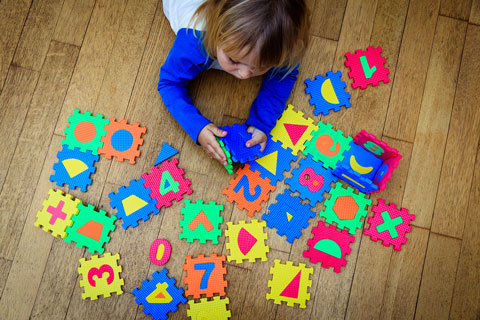Children ages 3-5 are learning that anything they count needs a “number name” (one block, two blocks) and that the list of number names has a set order (1-2-3-4). They may know that numbers stand for certain quantities. They notice that amounts change when things are added or removed. Here are some ways you can help preschool children learn about numbers. (See Illinois Early Learning and Development Benchmarks 6.A.ECa, 6.A.ECb, 6.A.ECc, 6.A.ECd, 6.B.ECb, 6.C.ECa, 6.D.ECa, and 10.B.ECa.)

Use the language of numbers.
- Use words like amount, enough, none, before/after, most, pair, take away.
- Help children ask and answer thought-provoking questions involving numbers: “How many of our caterpillars haven’t made cocoons?” “Do I have more silver keys or more gold keys? How can you tell?”
Make numbers part of the daily routine.
- Have children “sign in” by moving a nametag or other token from one basket to another. They can count leftover tokens to find out how many are absent.
- Ask children to set tables with one napkin and one cup per chair.
- Encourage voting on classroom issues. “Ten people want apples for snack Friday. Seven want crackers.”
Provide games that involve numbers and counting.
- Teach card games such as Go Fish, War (Top That), Animal Rummy.
- Provide games such as Tic Tac Toe, Mancala, Checkers.
- Use “choosing” games like One Potato Two Potato.
- Teach active games such as Farmer in the Dell, scavenger hunts, and variations on bowling.
Offer activities that promote working with numbers.
- Ask children to use tally marks to answer questions such as “How many cars in the lot?” or “Who has a pet at home?” They can tabulate the marks as a group.
- Help children construct graphs to compare amounts: “Did more people eat plain popcorn or cheese popcorn?”
- Provide blocks, integer rods, plastic animals, coins, etc., for making rows, pairs, and other groupings.
- Teach songs or fingerplays such as “Five Little Ducks” or “Ten Green Bottles.”
- Invite children to “hunt” for numbers around them.
- Post a number line and a 0-100 chart where the children can easily use them.
- Model using the principles of counting. Touch each object when counting aloud (“One bag, two bags, three bags. . .”).


 Printer-friendly PDF
Printer-friendly PDF PDF para imprimir
PDF para imprimir